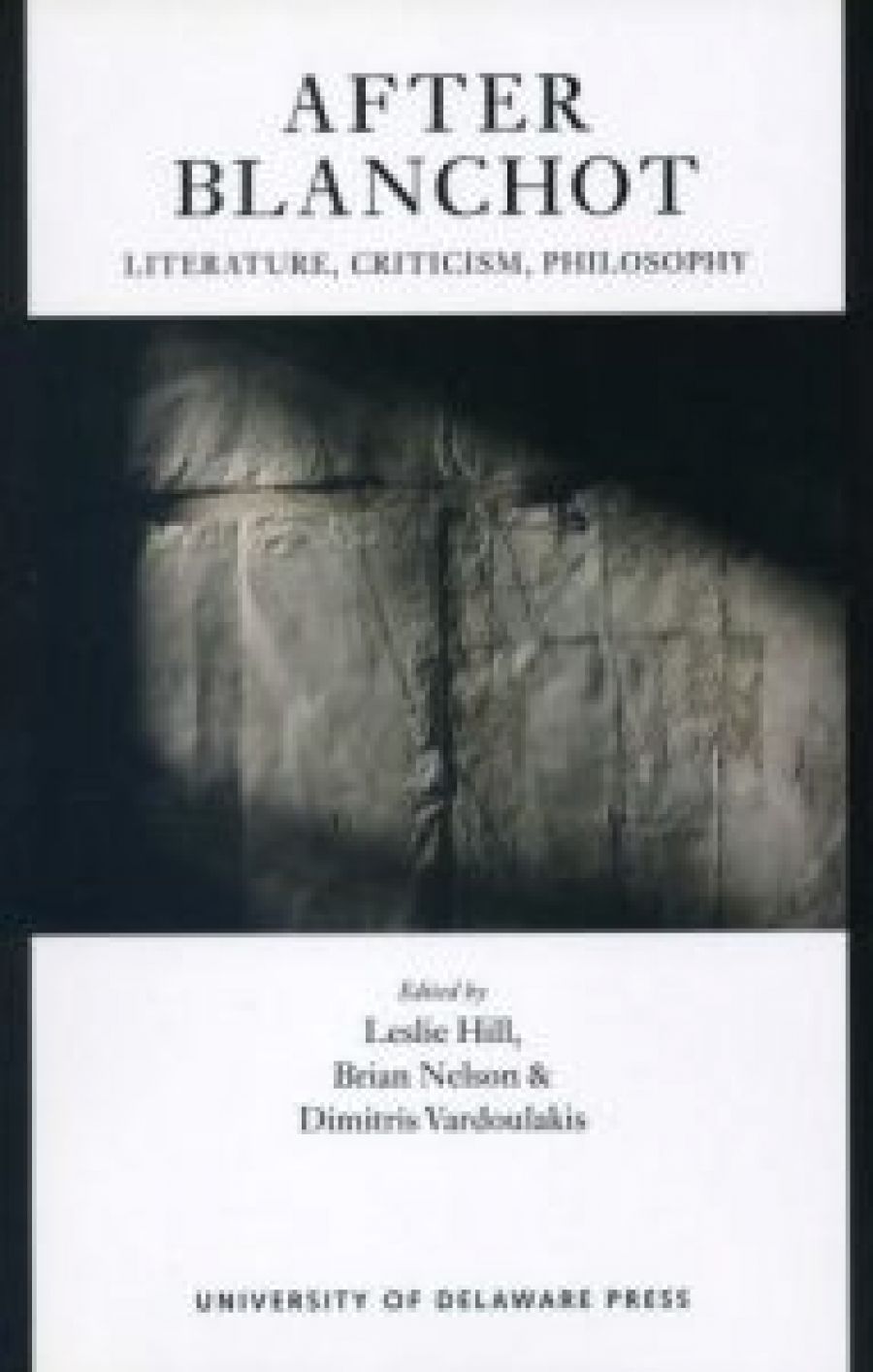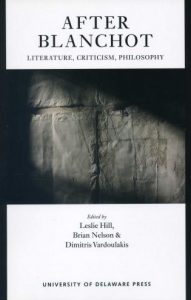
- Free Article: No
- Contents Category: Non-fiction
- Custom Article Title: A shape, if only a shape
- Review Article: Yes
- Article Title: A shape, if only a shape
- Online Only: No
- Custom Highlight Text:
When I introduce undergraduates to the work of Maurice Blanchot, I begin with three simple stories. In the first, a philosopher refuses to allow himself to be photographed. Foucault tells of engaging in vig-orous conversation at a May 1968 demonstration with a man he learned only later was the elusive Blanchot. He was the unrecognised colleague, invisible and self-effacing, but also enormously productive (Leslie Hill tells us that his works, if collected, would run to three dozen volumes). The second story is told in Blanchot’s TheWriting of the Disaster (1980), in which a small boy awakens at night, looks out into the blackness and sees no stars, no presence, ‘nothing beyond’. It is a remembered scene, riveting in its clarity, of originary loss and intimations of mortality. The third story is without doubt the most well known. In 1944, Blanchot faced execution by a Nazi firing squad but somehow, mysteriously, ‘escaped his own death’. This bizarre impossibility, the sense of death’s untimeliness and capricious propinquity, marks all Blanchot’s work, his essays, journalism, fiction and philosophy, and infuses it with a pervasively melancholic tone.
- Book 1 Title: After Blanchot
- Book 1 Subtitle: Literature, criticism, philosophy
- Book 1 Biblio: University of Delaware Press, $49.95 pb, 279 pp
- Book 1 Cover Small (400 x 600):

- Book 1 Cover (800 x 1200):

One of the most gifted French philosophers of the twentieth century – ranking, in particular, with Jacques Derrida and Emmanuel Levinas – he is also the scholar who is interested in how we might strive against the threat of non-being, how our work, our forms of symbolic labour, might make it possible to imagine mourning pre-emptively, as it were, and to find solace in forms of aesthetic self-fashioning. Blanchot’s writings on literature – on figures such as Mallarmé, Kafka, Celan and Rilke – are among the most conceptually radical one could hope to encounter, and are also penetrated to the core by his paradoxical metaphysics: death-knowing and death-defying, doing and undoing, in love with the night and with silence, but also finding it, in the end, utterly and painfully perilous. ‘Without death,’ Blanchot wrote in The Work of Fire (1949), ‘everything would sink into absurdity and nothingness.’ It is a typical statement, a possibly holy preoccupation, and it bears an affinity with what Derrida imagines as ‘the gift of death’, the ontological given against which everything else takes value.
After Blanchot is a collection of essays derived from a Melbourne conference organised in 2004 by Monash University. For one who missed this splendid event, it is exciting to see the calibre of the papers delivered and the audacious range of positions ratified in its compass. This is a uniformly brilliant collection of essays. (Other papers, for interested devotees, are collected in Colloquy, November 2005.) In the short scope of this review, it is impossible to do justice to After Blanchot. It is not just that the philosophical complexity of the volume is both daunting and enticing; it is that, like all serious-minded homages, the essays carry within them an aspect of mimicry of their figure of adoration, so that the effect of reading all fifteen essays in sequence is of reading Blanchot yet again, refracted and echoing, dispersed and relocated. There is a profound sense of epistemological solidarity, not just between each scholar and Blanchot, but also among the contributors themselves. There is also a concern, at the level of both stylistics and theorising, to honour the ‘singularities’ of Blanchot’s work, typified (to put it somewhat reductively) by oxymoronic formulations, constitutive anachronism and by all the tropes of achievement and failure implicit in the tale of Orpheus and Eurydice, a paradigmatic and sublime emblem for Blanchot of the status of the aesthetic and its relation to death and loss. What Blanchot once memorably called ‘the brittleness of the unsure’ is also evident in precious and stimulating ways.
The contributions range from those of well-known Blanchot scholars such as Leslie Hill, Christopher Bident and Kevin Hart, to local scholars such as Dimitris Vardoulakis, Caroline Scheaffer-Jones and Elizabeth Presa. These essays remind us, as Eleanor Kaufman points out in her wonderful piece on ‘Midnight’, how repetitious and consolidated are the movements of Blanchot’s thinking. Nevertheless, there are fine and original essays here on Blanchot’s connections with others – Levinas, René Girard, Paul de Man and Giorgio Caproni – which testify to the openness and excursiveness of his work, and to the ways in which he enters into perpetual forms of dialogue and philosophical mutuality. There are also densely interesting readings of major texts – Death Sentence (1948) and The Space of Literature (1955), in particular – and a clever study of the notion of ‘sacred speech’. Other papers consider the status of literary criticism, of ‘being Jewish’ and the sacred as a category that Blanchot (an atheist) seems both to avow and disavow. Just as Blanchot considered the process of reading necessary to bring the written ‘work’ into being, so After Blanchot reveals the richness of the ontological universe of a major scholar who repays the most diligent and fastidious attention.
Yet the final essay in the volume, by Elizabeth Presa, is one of the most surprising. Beginning with a sensuous description of plaster casting, Presa, a sculptor, moves to consider the centrality of the death mask to Blanchot’s poetics of art. Like Rilke, Blanchot possessed a copy of ‘L’Inconnue de la Seine’, the beautiful, smiling mask of a young girl who drowned in the Seine in the late nineteenth century. Presa finds in Blanchot’s interest in sculpture a fascinating analogy for his wish that art might fix and resurrect, that there might be a shape, if only a shape, that persists after death. It is a beautifully rhetorical gesture to complete an impressive and rigorous volume, for which the three editors and the contributors should be congratulated.


Comments powered by CComment